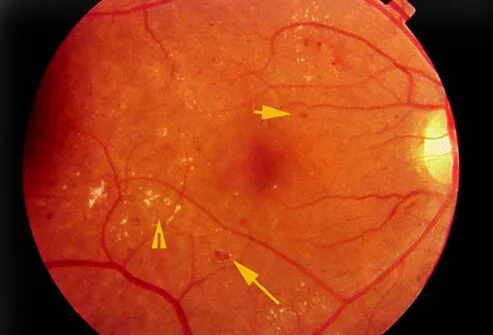Picture of Diabetic Retinopathy

Diabetic retinopathy, a common complication of diabetes, affects the blood vessels in the retina (the thin light-sensitive membrane that covers the back of the eye). It is due to the retina not receiving enough oxygen. If untreated, it may lead to blindness. If diagnosed and treated promptly, blindness is usually preventable. There are two types: nonproliferative and proliferative retinopathy. Nonproliferative retinopathy is the less severe type in which there may be hemorrhages (bleeding) in the retina and leakage of blood or serum causing a "wet retina." As a consequence vision may be diminished. Proliferative retinopathy is a more severe type of diabetic retinopathy. New abnormal fragile vessels develop on the surface of the retina and may grow toward the center of the eye. These vessels frequently bleed into the vitreous (the clear jelly in the center of the eye). Such bleeding episodes cause severe visual problems. Treatment is by laser surgery or surgery on the vitreous. These techniques can slow the progression of diabetic retinopathy and sometimes will reverse visual loss. However, damage done may be permanent. Diabetic retinopathy can often be prevented by lifestyle modification, including weight loss, dietary changes, and exercise. In addition, better control of high blood sugar decreases the incidence and the progression of diabetic retinopathy.
Image Source: Dr. Andrew A. Dahl, M.D., F.A.C.S.
Text: eMedicineHealth - Corneal Ulcer, WebMD - Corneal Ulcer